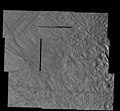Fichier:PIA01633 Tyre impact structure Europa.jpg

Taille de cet aperçu : 666 × 599 pixels. Autres résolutions : 267 × 240 pixels | 533 × 480 pixels | 853 × 768 pixels | 1 138 × 1 024 pixels | 2 540 × 2 286 pixels.
Fichier d’origine (2 540 × 2 286 pixels, taille du fichier : 1,28 Mio, type MIME : image/jpeg)
Historique du fichier
Cliquer sur une date et heure pour voir le fichier tel qu'il était à ce moment-là.
| Date et heure | Vignette | Dimensions | Utilisateur | Commentaire | |
|---|---|---|---|---|---|
| actuel | 22 février 2020 à 11:38 |  | 2 540 × 2 286 (1,28 Mio) | User-duck | Cropped using CropTool with lossless mode. |
| 14 mars 2010 à 00:53 |  | 2 686 × 2 494 (1,28 Mio) | WolfmanSF | {{Information |Description={{en|1=This mosaic shows the Tyre multi-ring structure which is thought to have been formed by a large impact onto Jupiter's moon Europa. The effective crater (large bull's-eye feature) is about 40 kilometers (25 miles) across w |
Utilisation du fichier
Les 3 pages suivantes utilisent ce fichier :
Usage global du fichier
Les autres wikis suivants utilisent ce fichier :
- Utilisation sur af.wikipedia.org
- Utilisation sur de.wikipedia.org
- Utilisation sur en.wikipedia.org
- Utilisation sur ko.wikipedia.org
- Utilisation sur mt.wikipedia.org
- Utilisation sur nn.wikipedia.org
- Utilisation sur no.wikipedia.org
- Utilisation sur ro.wikipedia.org
- Utilisation sur ru.wikipedia.org


